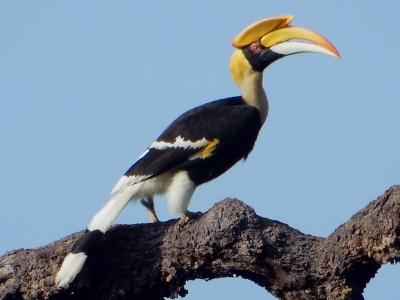
Hornbills have captivated the human race for centuries, especially indigenous forest communities around the world. There are numerous hornbill species, and most have their own myths. According to the Senufo people from the Ivory Coast of Africa, the hornbill was one of five original beings to roam the Earth and helped create humanity. In Indonesia, the Dayak and Iban people of Borneo consider the hornbill a messenger of the spirits and a symbol of virility, and in the New Ireland province of Papua New Guinea, they are considered carriers of the soul to the afterlife.
In India too, hornbills play a significant role in local lore. Eating the flesh of the great Indian hornbill was once considered a cure for deadly diseases, and hunters of the Nyishi tribes of Arunachal Pradesh believed that mounting the beak of the hornbill on their headgear gave them added strength. Thankfully, this is all in the past. Today, the tribes that once hunted the hornbills are working towards the conservation of the species to ensure its survival.
The great Indian hornbill can be sighted in reserve forests in Northeast India, in the Nilgiri mountains of Tamil Nadu, and in the jungles of the Western Ghats. They are a sight to behold, with their large beaks and school bus-yellow casques that sit like helmets on their heads. The casques were considered very valuable in China and Japan, where intricately carved, miniatures culptures were made from “hornbill ivory”.
The physiological function of the casque remains largely a mystery to scientists, though male hornbills have been known to engage in casque-butting to protect their territory. Femalestoo have casques, though they are marginally smaller in size. Both sexes use their handsome beaks to pick fruit, catch insects, and groom.
Hornbills are monogamous, deeply social creatures, and are often spotted in pairs, feeding each other fruits and other berries. After breeding, the female seals herself in the hollow of a tree using droppings and chewed up pieces of wood, leaving only a small opening. For the next three-four months, the male brings the female food every single day, feeding her through this hole. This continues until the chick is a few weeks old, and mother and child finally break the barrier and are reunited with the male.
Credit : Roundglass
Picture Credit : Google




